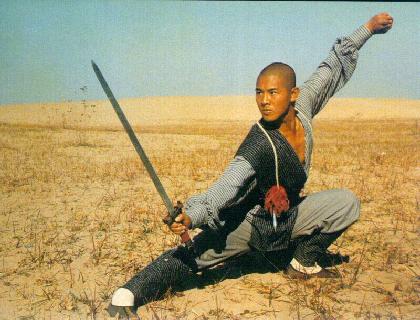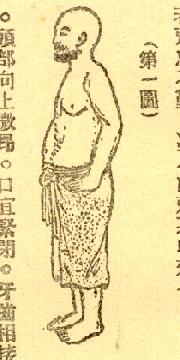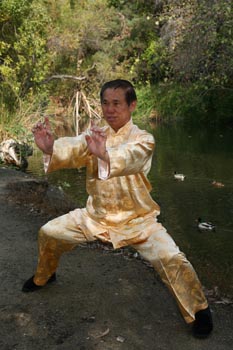October 2002 (Part 2)
SELECTION OF QUESTIONS AND ANSWERS

A beautiful kungfu form demonstrated by the celebrated movie star, Li Lian Jie or Jet Li, in the famous kungfu movie “Shaolin Temple”. What many people may not realize is that merely performing kungfu forms alone is not traditional kungfu training. No matter how long you may have practised kungfu forms and how beautifully you may perform them in solo demonstration, you will be unable to defend yourself if you have not trained force and combat application.
Question 1
I can only hold my horse stance for about 2 minutes. My master who has been practicing for over 20 years can remain in a horse stance for over an hour! This is what I aim to be able to do in a few years' time. I am reasonably fit and am in my early 20's. Is this a reasonable target for me to achieve within the next three years? I seriously doubt it but I am hopeful.
— Nathan, USA
Answer
I am glad that not only you realize the importance of stance training, but also you are willing to put in time and effort to achieve result. Stance training is probably the most important single exercise to develop internal force, and internal force is probably the most important factor in kungfu. Not only it contributes to your combat efficiency, it also contributes to your good health, mental freshness and spiritual joy.
As you have a master who himself can remain at the Horse-Riding Stance for over an hour — a remarkable achievement even for masters — you should ask him for advice. Nevertheless, I shall give you my advice too.
Your master can remain at the stance for over an hour because he has spent a lot of time and effort in his training. But you can achieve similar result in three years, which is a reasonable target to aim at. You can achieve similar result in shorter time not because you are smarter than your master, but because you have certain advantages he might not have.
You have at least two advantages. You are willing to seek advice, and presumably act on the advice. This enables you to be more cost-effective in your training. Secondly, you have a master who already has the result you aim at. He can therefore point you the way he himself has traveled, and personally correct fine points to enhance your result.
Three pieces of advice will be very useful. One, your training must be regular and consistent, at least once a day everyday. It is permissible if you miss your training once a while, but on the whole it must be regular and consistent. Two, you must progress gradually. Remain a bit longer, say a few seconds or one or two minutes longer, after every three days. Three, be physically, emotionally and mentally relax in your training. Here is where personal supervision from your master can be of great help.
But the most important advice, the one that you must follow before you even begin, is that you must be confident that you will succeed. This is overcoming your mental blockage. Once your mind is clear about your mission, your body and emotion will follow suit.
Question 2
Secondly I am seriously doubtful as to what I can achieve in kung fu since I am already over 20 years old. I am prepared to put in a lot of work into my training, but am never satisfied with the amount of progress I make.
Answer
Your worry is unfounded. As I have said earlier, it is most important that you must have confidence of your ability. There are two main approaches to develop this confidence. The first way is intellectual, and can be realized by seeking advice like what you are doing, and comprehending the reasons that you should succeed.
The second way is intuitive. According to Chinese medical thought, which may appear odd to those unfamiliar with it, confidence is closely related to one's bones and gall bladder system. If you strengthen them you would develop confidence intrinsicly. Sinew Metamorphosis, an advanced set of Shaolin chi kung exercises, is excellent for this purpose.
Being 20 is a very good age to train kungfu. Hard work is necessary, but you must also work smartly. If you just train and train, without really understanding what and why you are training, you would waste a lot of time. This, in fact, is the big problem with most people, often without their conscious knowing. They learn kungfu sets after kungfu sets, and often can perform them beautifully, but they never develop internal force nor practise combat application. As a result, after many years of training they still achieve little.
A main reason for their lack of achievement is their lack of vision and direction in their training. They do not really know what they want to achieve in their training, consequently they do not know where they are going.
While having vision and direction is important, you must also know your limitations. Set yourself goals which are reasonable, and which you can achieve readily if you put in effort. Be modest in your goals at first, such as being able to perform typical kungfu patterns flowingly, and savor your satisfaction when you achieve your modest goal. Then gradually increase the scope and depth of your achievement.
Question 3
It is also extremely hard for me as the other students in my class are very lazy and are satisfied with mediocre results. Although my master is very capable he never pushes his students to their limits. Can I reasonably expect to be a very good Kung fu fighter, if I put in a lot of work over the next 10 years?
Answer
If your classmates are lazy, it would be comparatively easier for you to achieve results. You could set yourself as a model for them to follow, instead of following your lazy classmates as your models.
But you need to be tactful as well as considerate. Sometimes you may have to slow down your progress so that they do not look too bad when compared to you. If you can do this, i.e. developing consideration and care for others, you would have achieved more than becoming a good fighter.
How good a fighter you will become depends not just on the length of your training but also on how you train. Many people cannot fight even after training so-called kungfu for thirty years, whereas others can fight well after three. You should aim not just to be a fighter, but to be a scholar-warrior, i.e. one who can fight well and at the same time be well versed in literature and philosophy, poetry and music.
Question 4
I would greatly appreciate it if you could share with me your experiences as a student when you were learning Kung Fu. Did you have similar doubts about yourself? At what age did you start training?
Answer
I started my life-long kungfu training when I was ten. I learned from four masters, all of whom were patriarchs of their respective styles. It was no co-incidence. I was (and still am) an idealist, I searched for the best available teachers.
I was a good student. I never had any doubt about my learning ability. In fact I was a fast learner; for example, I could learn a kungfu set by merely observing it three times.
But I also never pushed myself beyond my limits. I did exactly what my teachers told me, and never tried to be smarter than my teachers. If my teacher told me to practise a certain movement for three weeks, I would practise it for three weeks, though I could learn it in three minutes. I owed this attitude much to my father's advice.
The crucial point — which I discovered later only after comprehending the difference between skills and techniques — was that this was being smart. If my teacher asked me to practise for three weeks and I practised only for three minutes thinking that I already knew it, I would be very silly.
Another of my father's advice which benefited me greatly was that I respected my teachers deeply and sincerely. This gave me the ideal psychologcial frame of mind to learn well.
I trained diligently and consistently, averaging an hour a day, and often more. I read a lot too, and listened to stories as well as advice of my seniors and other masters. At one period I went round looking for martial artists from various marital arts to spar so as to improve my combat efficiency. At another period I went round looking for masters for advice to deepen my skills and knowledge.
I also involved myself in music, chess, poetry, philosophy, painting and science. I aspired to the Chinese ideal, i.e. a scholar-warrior. Later, when I was more advanced in my kungfu training, I aspired to the Shaolin ideal, i.e. a warrior-monk.

An essential dimension of traditional kungfu training is force development. The picture above taken from an old Shaolin classic shows an exercise from the famous “Yi Jin Jing” or “Sinew Metamorphosis” of Shaolin Kungfu for internal force training.
Question 5
My aim in my training is to be as good a practitioner as my master, but I think this is an unrealistic expectation. At the very least I want to be the best I can be.
Answer
It is a very good idea to be the best you can. One day you may even be better than your master, in which case he would be very proud. But you must always respect and honour him.
Question 6
A Japanese grandmaster states that you only need one day a week of internal training to acquire and maintain chi energy. However, you recommend practicing One Finger Zen daily. Is there any fault in the Japanese grandmaster's approach?
— Sensei Muscatello, USA
Answer
Different masters and grandmasters have different ways of training. The way I follow is to practise everyday. This is also the way recommmended by all Chinese masters and grandmasters throughout history, irrespective of what is practised but it is particularly important for internal force development like One-Finger Zen.
There is an important kungfu saying as follows, “yeit yeit sam chiow” (Cantonese pronunciation) or “everyday for three autumns”, meaning that if you wish to have good result you must practise everyday for three years.
There is also another saying, “yit shyu sap hon” or “one hot day followed by ten cold days”, meaning that if you prasctise for one day, then stop for ten, you will never achieve any result. Practising for one day, then stopping for six is almost as bad.
Skills or force take time to develop gradually. If you are hasty and accumulate too much force within too short a time, it can be harmful because your body and all its systems may not be ready for the extra force. Three years is a recommended period to accumulate a sufficiently high level of skills or force.
Why must one practise everyday? It is because if the two consecutive training sessions are too far apart, the force accumulated in the first session may dissipate before the next session, negating the accumulative effect.
But once you have accumulated a sufficient amount of skills or force, you need only to practise once a few days to maintain them. An analogy is boiling a pot of water. If you take the pot off the fire now and then, the water will never boil. If you leave the pot over the fire for a reasonable length of time, the water will eventually boil. Once the water is boiled, you need only to put the pot over the fire once a while to maintain the heat.
Question 7
I was interested in learning the combat aspects of Tai-Chi, Bagua, and Hsing-I and eventually Shaolin but with standpoint on focusing and strengthening my inner power or chi.
— Sal, USA
Answer
It is advisable to choose any one of the four arts above instead of learning all of them. Anyone of the above arts, if it is genuine, will develop your inner power or chi, besides enabling you to defend yourself. But if you learn their watered-down versions, you will be unable to defend yourself and have no inner power even if you learn all the four.
Question 8
I want to find a great instructor and one with the capability to teach me the real combat effective aspects or genuine art as opposed to a “watered down” version.
Answer
Today most of the martial arts taught are watered-down versions. Even to find a mediocre instructor teaching a genuine martial art is difficult, to find a great master is like finding a gem in a hay stack.
Question 9
Do you offer any video instruction for those not able to attend your seminars?
Answer
At present I do not offer any video instruction. Unless you are already familiar with the art, it is unlikely you can learn its combat aspects or inner power from a video. You may not even learn its outward forms correctly.

"Everyday for three autumns" is good advice for internal force training like "Golden Bridge" above
Question 10
And do you agree with my intention to learn first Tai Chi, Bagua, and Hsing-I before learning Shaolin Kungfu for combat applications?
Answer
No, I disagree. Choose one, learn and practise it well from a living instructor.
Question 11
Are there certain forms of qigong that are better to study for martial applications? What about Kung-fu, are there certain forms to study that are more effective?
Answer
The answer is yes and no to both of your questions. If all things were equal, yes, there are certain qigong and kungfu forms that are more effective than others for combat.
For example, at the beginning stage qigong forms like hitting a sandbag and kicking a pole (presuming that you practise them as qigong) and kungfu forms like straight-forward punches and kicks are more effective for combat than qigong forms like stance training and abdominal breathing and kungfu forms like tiger-claws and palm strikes. But at an advanced stage, stance training and abdominal breathing, tiger-claws and palm strikes are far more effective.
But things are almost always not equal. Irrespective of whether at the beginning or an advanced stage, and irrespective of whether you punch sandbags or practise stance training, kick your opponent or strike him with a palm, you will be more effective in combat if you learn from a good teacher, or if you are more skilful due to diligent training.
Question 12
Recently, I found out that I have mild scoliosis, which is an abnormal curvature in the spine. By practicing chi kung exercises such as the Three-Circle Stance, am I able to cure it at all?
— Stephen, USA
Answer
In theory any chi kung exercise, including the Three-Circle Stance, can cure you of your abnormal spine curvature, or of any disease. It may sound ridiculous to some people, but it is true that chi kung can overcome any disease.
In a nutshell, chi kung ensures harmonious energy flow, which is a Chinese medical jargon meaning that vital energy is enabling every part of your body to work properly. When this happens, you will not be sick.
But in practice, the Three-Circle Stance is more likely to aggravate your abnormal spine curvature. Why is this so? It is because the Three-Circle Stance is an inappropriate chi kung exercise for your spine problem.
The Three-Circle Stance is a simple exercise. You just remain at the same one pose for a length of time. Paradoxically, because it is simple, it is easy to make mistakes if you train on your own without supervision from a qualified instructor.
After standing at the one pose for some time, you may bend your back, or you may tense your back muscles, and you may not realize it. And because there is only one pose, just one mistake will render your training one hundred per cent wrong! (If there are 10 moves in the exercise, when you make one mistake you are only ten per cent wrong.) This means that the more you train, the more harm you will do to yourself.
An excellent chi kung exercise to overcome abnormal spine curvature is self manifested chi movement. But you have to learn from, and practise this exercise under the supervision of, a qualified instructor.
